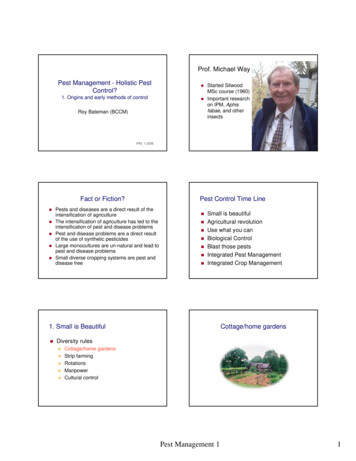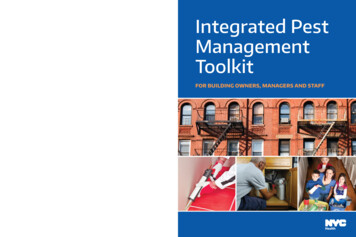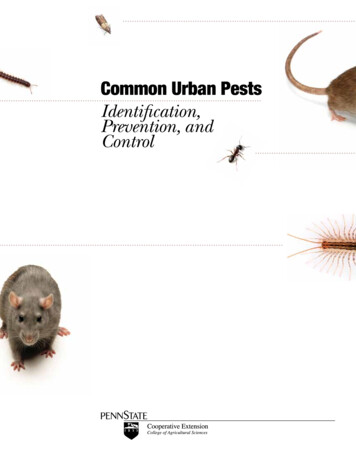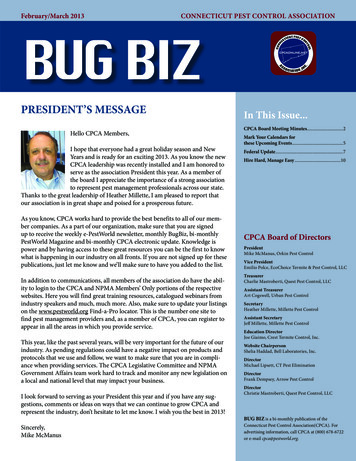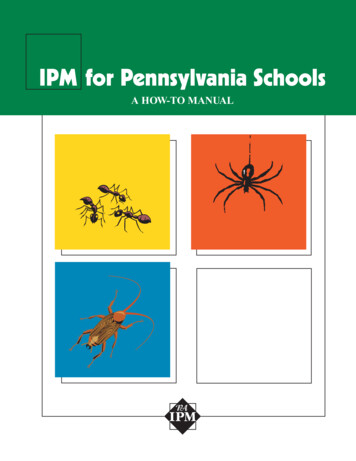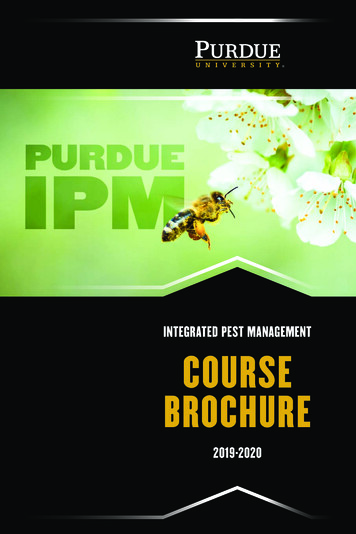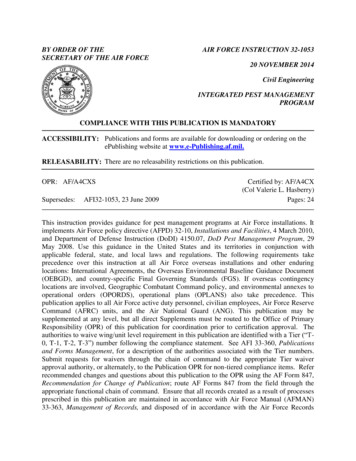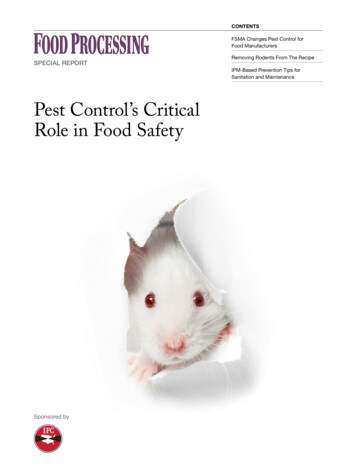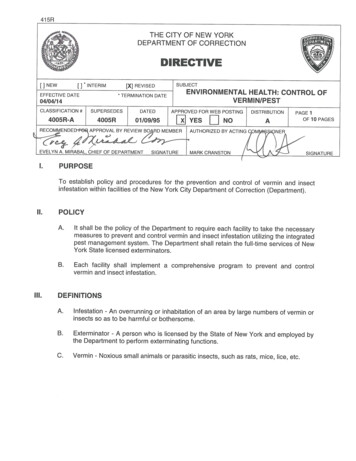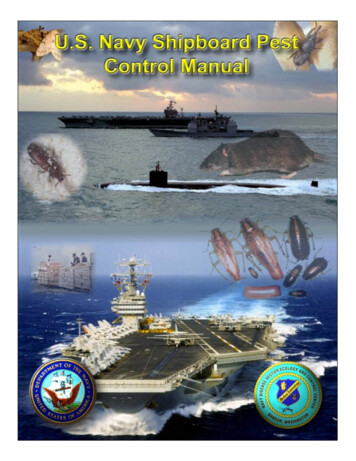
Transcription
Biological ControlPest Management - HolisticPest Control?2. Modern control tactics and the birth of IPMThe action of parasites, predators, andpathogens in maintaining anotherorganism’s density at a lower averagethan would occur in their absenceDe Bach (1964)IPM 2 2008Biological Control American Innovation– Plums in Missouri– Sunny California Cottony-cushion scale Tropical islands Not always a Success!– Partula snailsBiological Control Islands in the SunBiological Control American Innovation– Plum curculio in Missouri– First case of transportingparasitic insect from onelocality to another(CV Riley, 1869)Cottony-cushion scale in California 1888-89– Hawaii:Sugar cane weevil– Mauritius:Rhinoceros beetlePest Management 21
Biological ControlNot always a Success!e.g. Partula snails in PolynesiaAfrican land snails were introduced toTahiti as a source of food - theyescaped and started eating crops.1974 , in an effort to control the landsnails, a smaller predatory speciesof snail was introduced; Euglandinarosea.This species started to feed on thenative Polynesian tree snails.Partula nodosa: one of nine speciesonce common on Tahiti; 3 nowextinct in the wildPlant breeding Crop improvement– Bigger yields, better quality Plant resistance– Pest and disease control What are the pay-offs?Plant Resistance Grape phylloxeraHessian fly on wheatWheat stem sawflyChinch bug onsorghum Bugs on cottonBlast Those Pests! DDT and otherorganochlorines OPs Carbamates Pyrethroids IGRs Neonicotinoids Etc .Pest Management 22
The Pesticide Debate:Costs and BenefitsBlast Those Pests! The chemical barrage, as crude a weapon as acaveman’s club, has been hurled against thefabric of life Rachel Carson: Silent SpringRachel Carson (1962) Resistance If pesticides were completely banned, croplosses would probably soar to 50% and foodprices would increase 4-5 fold ResurgenceNorman Borlaug (1972), Nobel Prize Winner for work onthe Green RevolutionIntegrated Pest Management?More recently Let a man profess to have discovered some newPatent Powder Pimperlimplimp, a single pinch ofwhich being thrown into each corner of a field willkill every bug throughout its whole extent, andpeople will listen to him with attention and respect.But tell them of any simple common-sense plan,based upon correct scientific principles, to checkand keep within reasonable bounds the insect foesof the farmer, and they will laugh you to scorn. Is organic reallybetter for health &the environment? Does fair trade helpthe majority? “Food miles” misleading?The Practical Entomologist - Benjamin Walsh, (1866)9 December 2006Organic / biodynamic farmingHow is biodynamic different from organic? Every biodynamic farm aims to become self-sufficient incompost, manures and animal feeds. All external inputs are kept to a minimum. Compost is treated with special herb-basedpreparations. Crop quality is improved using natural manure andquartz based preparations. Ecological diversity is a goal of landscapemanagement. An astronomical calendar is used to determineauspicious, planting, cultivating and harvesting times.Integrated Pest Management (IPM) –first formal definitionIntegrated Pest Control is applied pestcontrol which combines and integratesbiological and chemical control –Stern et al (1959)www.biodynamic.org.uk/Pest Management 23
IPMIntegrated Pest Management (IPM)Integrated Pest Management is theintelligent selection and use of pest controlmeasures to ensure favourable economic,ecological and sociological consequencesThe ‘IPM pyramid’Basic Components of an IPMProgramme“Conventional”Intervention The aims of IPM are to Modify the population of the pest toachieve levels below the economicthreshold Apply all suitable biological andtechnological knowledge to achieve this Do this in a manner compatible witheconomic and environmentalrequirements.Pesti-cide Prevention“Biorational”Biological ObservationPhysical-mechanical InterventionCulturalPreventionPrevention – indirect measures Aim to limit or prevent initial severity ofpests– Crop location– Crop rotation– Crop husbandry– Plant breeding– Habitat managementObservation – Decision tools To determine when and what action to take– Crop monitoring– Decision support systems– Area-wide management Trap cropping Inter-croppingPest Management 24
Deciding when to interveneIntervention – direct measuresThresholds To reduce effects of damaging pestpopulations to acceptable levels– Action threshold Pest density that warrants initiation of a control measure– Cultural– Biological– Interference– Chemical– Economic damage threshold Amount of damage that justifies the cost of controls– Economic injury level Lowest pest density that will cause economic damage– Economic threshold Level at which controls should be implemented toprevent increasing pest population reaching economicinjury levelIntegrated Crop Management (ICM),Integrated Farming Systems (IFS)Summary of available methodsRational UseIntegrated Crop Management is acropping strategy in which the grower seeksto conserve and enhance the environmentwhile economically producing a safe andwholesome product. Its long term aim is tooptimise the needs of consumers, society,the environment and the producer.PesticidesBiologicalHost plantresistanceIntegrated PestManagementQuarantineCulturalInterferenceOr is “Good Agricultural Practice” (GAP) abetter expression? “Integrated Pest Management” (IPM) oralternatively “Incredibly Popular Mantra” “Integrated Crop Management” (ICM) oralternatively “Input Costs Marginalized” “Integrated Farming Systems” (IFS) oralternatively “Inadequately FundedSolution”ICM - GAP Conservation headlandsCrop islandsDiversitySoil scienceIPMGM cropswww.dropdata.orgPest Management 25
Pest Management - Holistic Pest Control? 2. Modern control tactics and the birth of IPM IPM_2 2008 Biological Control The action of parasites, predators, and pathogens in maintaining another organism's density at a lower average than would occur in their absence De Bach (1964)
